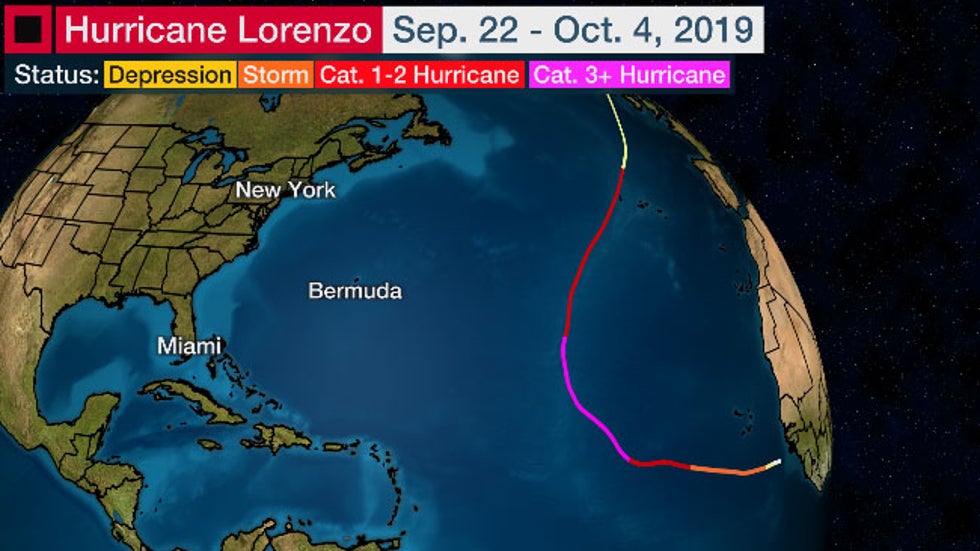Jonathan Erdman
Hurricane Larry won't track anywhere near the U.S. East Coast, but like other distant storms, it poses one indirect danger that has proven deadly in the past: rip currents.
Larry intensified into a large Category 3 hurricane over Labor Day weekend and is currently over the open waters of the central Atlantic Ocean.
It will pass just east of Bermuda Thursday, then curl northeastward toward eastern Newfoundland, Canada, late this week.
(MAP: Interactive Hurricane Larry Forecast Path)
Before it curls away from Bermuda, Larry’s center will track no closer than 700 miles from the East Coast.
We won’t have to worry about threats from storm surge, flooding rain, damaging winds or tornadoes along the East Coast as we saw last week with Hurricane Ida.
So why is there concern over a hurricane hundreds of miles away that isn’t forecast to track anywhere near the East Coast?
Larry Is a Wave Generator
Winds blowing over the ocean produce waves. In the case of a hurricane, these strong winds blowing over larger areas of the ocean generate waves that propagate away from the storm, known as swells.
For a hurricane in the central Atlantic Ocean like Larry, these swells are reaching the north- and east-facing coasts of the Leeward Islands, Puerto Rico, Hispaniola, the Bahamas and most of the U.S. East Coast.

When these swells reach shallow water near the coast, they produce breaking waves and rip currents that can last for several days before the storm moves away. It's a danger that shouldn’t be taken lightly.
Rip Current Danger
A rip current is a strong but narrow current that flows away from the beach. Rip currents can form at any beach with breaking waves.
The speed of a rip current can exceed 6 miles per hour – faster than an Olympic swimmer – and can extend the length of a football field off the coast.
According to the National Weather Service, over 30,000 rip current rescues occur on U.S. beaches each year.
Since 2011, rip currents have claimed an average of 60 lives each year in the U.S., more than double the number of lightning fatalities.
(MORE: How to Spot a Rip Current and How to Survive)
Recent Distant Hurricane Rip Current Deaths
Last September, three rip current drownings – two in Puerto Rico and one in New Jersey – were attributed to Hurricane Teddy, which also tracked east of Bermuda, according to the National Hurricane Center's final report. Teddy’s pounding waves also produced some coastal flooding from Florida to Maine, including three straight days of major coastal flooding in Charleston, South Carolina.
One week before Teddy, Hurricane Paulette ran over Bermuda and its generated waves led to two rip current deaths in South Carolina and New Jersey.
Perhaps the most distant recent example was 2019's Hurricane Lorenzo.
This hurricane topped out at Category 5 strength almost 2,000 miles from North Carolina’s Outer Banks, the strongest on record in the eastern Atlantic Ocean.
Despite that massive distance, dangerous surf or rip currents generated from Lorenzo were responsible for eight deaths along the East Coast, including a pair of teenagers at Rockaway Beach, New York; a fisherman who fell in the water in Rhode Island; a swimmer in Vero Beach, Florida; and four who died on the beaches of North Carolina’s Outer Banks.
 Track history of Hurricane Lorenzo in 2019.
Track history of Hurricane Lorenzo in 2019.Even if the weather otherwise looks OK, it's a good idea to avoid getting in the water along the East Coast the next few days due to this rip current threat from distant Hurricane Larry, particularly if there is a yellow (moderate risk) or red (high risk) flag flying at the beach.
The Weather Company’s primary journalistic mission is to report on breaking weather news, the environment and the importance of science to our lives. This story does not necessarily represent the position of our parent company, IBM.
The Weather Company’s primary journalistic mission is to report on breaking weather news, the environment and the importance of science to our lives. This story does not necessarily represent the position of our parent company, IBM.

No comments:
Post a Comment